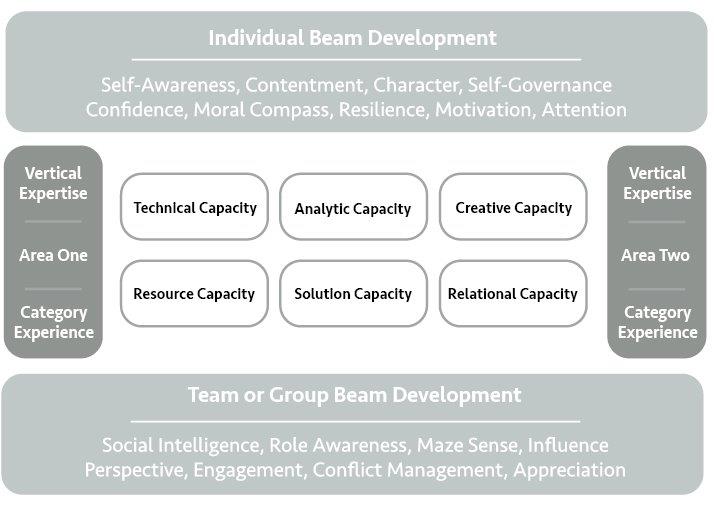Talent Blocks and Beams: A Tool for Building Teams That Get Stuff Done

The work of a strategic team — that is, a team whose mission is to make strategy happen — is crucial to any organization’s survival and growth. However, cultivating the right blend of talent for such a team requires far more than the normal recruiting, development,and retention efforts.
I’ve helped companies large and small think about how to build the right strategic team for a given objective — for example, planning to manage and execute growth or performance strategy, improving key processes or systems, supporting change, etc.
In the course of my work, I’ve found it’s helpful to think in terms of what my team and I refer to as “talent blocks and beams.” A team is a lot like a building: It needs a sturdy structure in place to weather all manner of environmental conditions. Without the right structure, a team will not be capable of adapting and expanding as the needs of the enterprise evolve.
The blocks and beams approach is designed to help you think in terms of both the foundational competencies (blocks) each team member brings to the mix and the professional and personal strengths (beams) they have to provide structure and carry weight.

What Are ‘Talent Blocks’?
Thinking about talent blocks will help you map six areas of capability and experience that people possess, spanning all relevant areas of business expertise. These include a range of both hard and soft competencies that are important across the organization:
- Technical competency: Reflecting a domain-specific knowledge base, subject expertise, and operating know-how
- Analytical competency: Reflecting a person’s facility with data, systems, patterns, signals, measures, etc.
- Creative competency: Reflecting the ability to constructively imagine solutions and manage ideas
- Resource-based competency: Reflecting the ability to manage critical assets, time, and budgets
- Solution-based competency: Reflecting the ability to assess, deconstruct, and solve problems
- Relational competency: Reflecting the ability to bring out the best in others
To get a clearer idea of how these talent blocks apply to real-world teams, let’s consider an example. Say Carla and James lead an aerospace-industry product-development team charged with moving a major program forward into the operations and commercial start-up phase. Their team has been designed to develop, test, and qualify a sophisticated new offering for a component supply partner and to make sure all those involved are on the same page about the information and messages being exchanged.
Originally, the team’s work depended most heavily on their core technical, analytic, and creative skills. As the project has evolved, though, the team has collaborated with a number of groups with disparate goals and experiences. In order to succeed with these other stakeholders, they’ve needed to rely more heavily on their combined relational, solution-based, and resource-based skills. These talent blocks have more to do with integration, navigation, adaptation, and improvised efforts.
As teams transition and advance in their specific roles and charters, their talent blocks are very likely to evolve along with the stages and phases of the work to be done. Sometimes, players need to be traded — that is, substitutions of team members are needed — in order to ensure the team has all the blocks required to proceed.
For more expert HR insights, check out the latest issue of Recruiter.com Magazine:
What Are ‘Talent Beams’?
Talent beams, on the other hand, provide a guide for mapping a person’s specific professional expertise and training (their “vertical beams”), as well as the personal and social characteristics (their “horizontal beams”) that influence the way they behave, such as self-awareness and social intelligence.
By way of example, let’s say Rocco and Marge are the leads on a project that deals with customer connections and service agreements with a medical equipment company known for its superior customer service and support. Marge, a 35-year veteran of the field, and Rocco, a 30-year-old engineer, share the task of a large service-model implementation project that would address a number of technical operating and economic benefits for both customers and the company.
Marge has deep and hard grooves of experience and the knack of an expert who has intervened in thousands of service problems. Rocco brings software savvy, process and system experience from other sectors, and a sense for customer-driven service interactions. These two professionals are both sharp in their own way, but together they can balance their currency of expertise and experience with their maturity of personal and organizational insight, influence, and impact. The vertical beams of expertise and experience and the horizontal beams of self-governance and social capability can be a very nice match when paired together thoughtfully.
Why Blocks and Beams Matter
On a strategic team, the determination of role assignments matters a great deal. By considering team composition in terms of talent blocks and beams, you can ultimately do a better job of answering key questions for a strategic team, including:
- Who organizes and arranges?
- Who brings expertise and subject-matter knowledge?
- Who are the integrators and improvisers?
- Who are the navigators and pathfinders?
- Who are the operators, task producers, and work checkers?
You’ll also be in a much stronger position to evaluate whether certain people will work together effectively, and whether their work will actually do something that yields meaningful results. In other words: With a blocks and beams framework, you can craft a team that actually gets the right stuff done.
Daniel Wolf is president and cofounder of Dewar Sloan and the author ofStrategic Teams and Development: The Fieldbook for People Making Strategy Happen .

